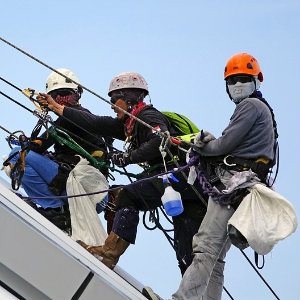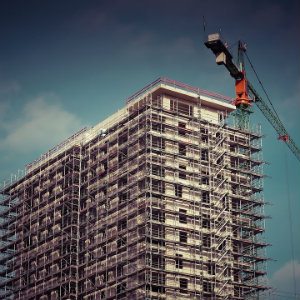After nearly three years and many days in court, Chief Administrative Law Judge Covette Rooney determined that Flintlock Construction Services LLC of Mamaroneck, New York, was guilty of failing to provide necessary safety standards to employees.
The Original Citations
In March of 2013, the Occupational Safety & Health Administration performed an investigation of a construction site where Flintlock Construction Services was working as the general contractor. Six months later, after concluding that investigation, they announced that they were citing the company for seven violations of OSHA’s scaffolding and fall protection safety standards. According to the report, the failure to maintain these safety standards exposed workers to falls of up to 26 feet.

- Guardrails
- Fall-Arrest Systems
- A safe means of access
- Full planking on the scaffolds
- Inadequate anchorage
- No “tie-offs” to prevent the structures from tipping
OSHA also announced that they had proposed large fines of $249,920 because they found that these violations were willful, meaning that the company had committed these violations with the knowledge of the safety standards and the danger that they were placing their employees in by failing to correct the situation.
Flintlock’s Appeal
The company appealed the citations and penalties, saying that they did not have knowledge of the hazards and that they had attempted to comply with the safety standards.
The Judge’s Decision
After several days in court, witness testimony, and a review of evidence, Judge Rooney determined that Flintlock did in fact have prior knowledge of the scaffolding issues.
According the written copy of the decision, the company had subcontracted with a business called Site Safety, whose job it was to perform daily inspections of the job site and inform the contractor of any safety violations that needed to be prepared. The onsite safety manager provided by the subcontractor had provided daily logs – which were available for review at any time. The daily logs from March of 2013 indicated safety issues with the scaffolds on the project. The logs also indicated that he had called the contractor, as well as several superintendents, and verbally informed them of the seriousness of the safety violations and that they needed to be brought up to code before any employee used them. On March 15th, 2013, the log indicated that he had once again approached one of the contractor’s superintendent, a Mr. Gomez, and was told that Mr. Gomez was “in no mood to deal with my concerns” and that he needed to leave him alone.
The manager then reported the issues to his superiors at Site Safety and took photographs of the scaffolding which showed the lack of bracing, fall protection, planking, and tie-offs.
The OSHA inspection took place just days later on March 21st, 2013 and the manager’s reports were confirmed.
In his final decision, Judge Rooney reported that “I find Flintlock demonstrated plain indifference to employee safety. Flintlock ignored the obvious hazardous conditions.”
OSHA’s regional administrator in New York, Robert Kulick, stated that “This was a clear case of an employer knowingly placing its employees at risk of deadly or disabling injuries caused by the number one killer in construction work – falls. Judge Rooney’s decision upholds our findings and reiterates an important fact: Employers cannot ignore their legal responsibility to safeguard their employees and adhere to workplace safety standards.”
Falls In Construction
According to OSHA, the most violated safety standards relate to fall protection. In fact, falls are part of what the administration refers to as the “Fatal Four”, the most dangerous hazards found on a construction site. These hazards lead to the most injuries and deaths in the construction industry every year.
Available Forms Of Protection
There are numerous ways in which employers can reduce the risk of a fall for their employees.
Engineering Changes
If work can be done on ground level, it is always better to transition the job there. If the work needs to be done at a high, the design and construction of any scaffolding or platforms needs to be carefully observed and monitored by a qualified individual. In addition, proper planking, railings, toeboards, and a secure access need to be installed.
Personal Protective Equipment (PPE)
There are three categories of PPEs:
Positioning
These devices can hold a worker in the proper place so that they can do their jobs hands free and are made up of an anchor point, body wear, connecting device, and fall arrest backup. Any device used for this purpose must limit free fall to less than two feet.
Restraint
This type of device prevents a worker from going over an unprotected edge by having a fixed length on the connecting device.
Personal Fall Arrest System
This device is used to stop a fall and to also prevent or minimize injury by absorbing the energy produced in a fall event.
Regular Inspections
Both the PPEs and any other equipment used should be inspected every day for wear and tear or damage.
What Are An Employee’s Rights After A Fall?
If an employee has been injured due to a fall while working, they typically have the right to file a workers’ compensation claim.

This does not, however, mean that an injured employee is prevented from suing a third-party who was responsible for their fall. For example, if an employee falls from scaffolding because the safety gear they were provided was defective in some way, they may be able to file a lawsuit against the manufacturer of that gear.
How Can I Prove That A Third Party Was At Fault?
Proving that someone else was at fault may be as simple as showing that there was a recall of their product due to a dangerous defect. However, in many cases, it is simply easier to allow an attorney to assist you with an investigation into the cause of the accident. It takes time, resources, and frequently knowledge of the law to uncover what someone else may be trying to hide.
Often, law firms have a group of experts who are well versed in the common issues faced by construction accident victims and who can testify on the plaintiff’s behalf, explaining why someone else’s negligence resulted in your accident. Medical experts are also available to speak about the serious nature of your injuries and how they may temporarily or permanently impact your career and quality of life.
What If My Doctor Says I’m Permanently Disabled?
Depending on the extend of your injuries and the progress that the medical professionals believe you can make, it may be possible to obtain Social Security Disability Benefits. To learn more about whether or not you qualify or how to file for these benefits, contact our offices, conveniently located in White Plains, Brooklyn, and Long Island.
